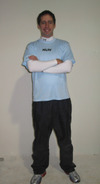Check out this article from army.mil/news
Military Downplaying Long Runs, Adopting More Diverse Fitness Programs
http://www.army.mil/-news/2007/02/26/1986-military-playing-down-long-runs-adopting-more-diverse-fitness-programs/
Ok, so I’ll give you the Cliff’s Notes version here:
"If a little bit of running is good for keeping warfighters in top form, then a lot of running is better, right? "Wrong!" say officials here at the Army Center for Health Promotion and Preventive Medicine."
"We’re not going soft," Bullock said. "What we’re doing is increasing the intensity of the training, and the effect on heart, lungs and overall strength is actually better."
"Higher-intensity, shorter-distance runs and interval training increase troops’ speed and stamina with less risk of injuries, he said. At the same time, this more balanced approach to PT actually improves their ability to perform in combat."

Shorter, faster runs get a thumbs up from girls in camo bikinis.
So we know that long slow runs suck for fat loss, and that the best way to lose fat is short, intense cardio sessions. Now we know that long slow runs also suck for fitness. Now while you might not be training for military readiness – you are going to be more fit for any task you need to perform by doing short fast intense cardio.
 By Josh Hillis
By Josh Hillis
Author of How To Lose The Stubborn Seven Pounds: Take Your Body from Good to Rockstar.
National Academy of Sports Medicine Certified Personal Trainer (NASM-CPT) and Performance Enhancement Specialist (NASM-PES),
and currently studing the Corrective Exercise Specialist (NASM-CES)˚ credential.
Russian Kettlebell Challenge Certified Instructor (RKC)* and Combat Applications Specialist (RKC2/CAS)
*RKC certified 2004-2006, registered to recertify 2007
˚NASM-CES will be completed 2007
© Joshua Hillis 2007
-Josh
So I know from my own experience and studying that more intense = better (usually). But how come we are taught that fat loss usually occurs after 30min of cardio? What you say makes sense to me but does this mean we need to change some text books?
Donald,
As a veteran I know well that this article means that instead of running for 45 minutes to an hour at a steady pace, the military will be considering an increase in workouts that consist of 20-30 minutes of an intense cardio workout, such as sprinting and circuit training, and the remaining half hour on some other form of exercise; perhaps weight lifting or other cardio that doesn’t involve running. It all depends on your definition of a “short, workout” and in the military, a 30 minute workout is an easy, easy morning.